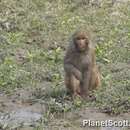en
names in breadcrumbs


The Assam macaque (Macaca assamensis) or Assamese macaque is a macaque of the Old World monkey family native to South and Southeast Asia. Since 2008, it has been listed as Near Threatened on the IUCN Red List, as it is experiencing significant declines due to poaching, habitat degradation, and fragmentation.[2]
The Assam macaque has a yellowish-grey to dark brown pelage. The facial skin is dark brownish to purplish. The head has a dark fringe of hair on the cheeks directed backwards to the ears. The hair on the crown is parted in the middle. The shoulders, head and arms tend to be paler than the hindquarters, which are greyish. The tail is well-haired and short. Head-to-body-length measures 51 to 73.5 cm (20.1 to 28.9 in), and the tail is 15 to 30 cm (5.9 to 11.8 in) long. Adult weight is 5 to 10 kg (11 to 22 lb).[3]
The Macaca assamensis "Nepal population" is endemic to Nepal and likely in some way distinct from the two recognized subspecies, which occupy adjacent areas to the southeast and east of the range of M. assamensis. There is a gap in northeastern India between the two main population pockets, specifically between central Bhutan and the south side of the Brahmaputra River; the east bank of its upper course marks the division between the two recognized subspecies:[4]
During surveys carried out in 1976, 1978, and 1984 in Nepal, Assam macaques were found to be patchily distributed along rivers in tropical and subtropical forests at altitudes from 200 to 1,800 metres (660 to 5,910 ft). They are apparently absent from areas west of the Kaligandaki River.[5] In India, they live in tropical and subtropical semievergreen forests, dry deciduous and montane forests, from the sea level to altitudes of 4,000 metres (13,000 ft).[6] They usually inhabit hill areas above 1,000 m (3,300 ft), but in the wetter east they may occur even in the lowlands, and frequent areas that only marginally reach this altitude. In Laos and Vietnam, they prefer high altitudes, usually above 500 m (1,600 ft). In forests on limestone karst, they occur in much lower elevations.[2]
Assam macaques are diurnal, and at times both arboreal and terrestrial. They are omnivorous and feed on fruits, leaves, invertebrates and cereals.[2] In Namdapha National Park, Arunachal Pradesh, 15 groups were recorded in 2002 comprising 209 individuals. The population had a group density of 1.11 individuals per 1 km2 (0.39 sq mi), and an average group size of 13.93 individuals.[7] During a survey in Nepal's Langtang National Park in 2007, a total of 213 Assamese macaques were encountered in 9 groups in the study area of 113 km2 (44 sq mi). Troop sizes varied between 13 and 35 individuals, with a mean troop size of 23.66 individuals, and comprised 31% adult females, 16% adult males, and their young of various ages. They preferred maize kernals, followed by potato tubers, but also raided fields with wheat, buckwheat, and millet.[8]
The threats to this species' habitat include selective logging and various forms of anthropogenic development and activities, alien invasives, hunting and trapping for sport, medicine, food, and the pet trade. Additionally, hybridization with adjacent species poses a threat to some populations.[9]
Macaca assamensis is listed in CITES Appendix II. It is legally protected in all countries of occurrence. For the populations in India, the species is listed under Schedule II, part I of the Indian Wildlife Act.[7]
 M. a. pelops in Nagarjun Forest, Kathmandu, Nepal
M. a. pelops in Nagarjun Forest, Kathmandu, Nepal The Assam macaque (Macaca assamensis) or Assamese macaque is a macaque of the Old World monkey family native to South and Southeast Asia. Since 2008, it has been listed as Near Threatened on the IUCN Red List, as it is experiencing significant declines due to poaching, habitat degradation, and fragmentation.